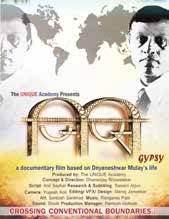
The New York Indian Film Festival (NYIFF) is the oldest, most prestigious film festival screening premieres of feature, documentary and short films made from, of, and about the Indian subcontinent in the Independent, arthouse, alternate and diaspora genres. Seven days of screenings, post-screening discussions, industry panels, award ceremony, special events, nightly networking parties, red carpet galas, media attention and packed audiences build an awareness of Indian cinema, entertain & educate North Americans about the real India, and add to the amazing cultural diversity of New York City.
The 17th IAFF was held from April 30 to May 7, 2017 in New York City. A total of 85 entries were received.
Aroon Sivadasani, President and Executive Director heads a team of people deeply committed to promotion of cinema. Eminent persons from the world of arts and cinema which include Salman Rushdie, Shashi Throop, Mira Nair, Shabana Azmi, Deepa Mehta, Shyam Benegal, Mani Ratnam, Madhur Jaffrey, Sabrina Dhawan and Sakina Jaffrey are on the advisory board of the film festival.
The Indo-American Arts Council, the organization which organizes the film festival says its missionis to promote and build the  awareness, creation, production, exhibition, publication and performance of Indian and cross-cultural art forms in North America. awareness, creation, production, exhibition, publication and performance of Indian and cross-cultural art forms in North America.
The Mission statement further says: “The IAAC supports all artistic disciplines in the classical, fusion, folk and innovative forms influenced by the arts of India. We work cooperatively with colleagues around the United States to broaden our collective audiences and to create a network for shared information, resources and funding.
“Our focus is to work with artists and arts organizations in North America as well as to facilitate artists and arts organizations from India to exhibit, perform and produce their works here”.
Well known photographer Jay Mandal who was on assignment with the IAFF 2017 has come up with some wonderful pictures of the event which we are happy to share with the readers of The Indian Panorama. |
 85 South Asian films screened at the 17thNYIFF
‘Gypsy’: Story of a village kid who rose to the top of Indian Bureaucracy received mixed reactions
By Ashok Ojha NEW YORK (TIP): The 17th annual New York Indian Film Festival is a celebration of off-the-track movies produced in South Asia. Launched on April 30 with the screening of ‘Lipstick under my Burkha’, a story of struggle of women fighting for their freedom and aspirations, the festival was well appreciated by New Yorkers. Approximately 85 shorts, documentaries and feature films from South Asian countries (India, Pakistan, Sri Lanka & Bangladesh), made in Hindi, English and seven regional languages (Tamil, Malayalam, Kannada, Punjabi, Marathi, Gujarati and Bengali) were entered in the festival.
‘Gypsy’, is based on Mulay’s autobiographical work ‘Maati, Pankh and Akash’, a celebrated Marathi literary work, depicting the struggle of a boy born in a remote village in Maharashtra. It is the story of a poet who rose to the post of the Consul General of India in New York with sheer hard work and perseverance.
Ambassador Dnyaneshwar Mulay is a true son of the soil. He calls his journey as that of a gypsy, who travelled to Tokyo, Syria and New York negotiating meanings out of political and diplomatic developments, engaging in as a competent diplomat with a poetic flavor, winning the hearts of Indian settlers as well as counterparts in the host countries. With his vision deeply rooted in the socio-cultural domain of India, Mulay, currently Secretary in-charge of Overseas Indian affairs in the Ministry of External Affairs, represents the aspirations of all Indians who belong to the impoverished strata of India, an India that lacks drinking water and nutritious food even after 75 years of India’s independence. Mulay’s success is an indicator that kids from the poorest economic levels can succeed and rise to the top.
But does the movie, ‘Gypsy’, succeed in presenting the true colors of Mulay’s personality? Dhananjay, the young filmmaker from Maharashtra, captures a few touching moments of Mulay’s childhood life in Laat village of Kolhapur district, where he inherited traditional poverty and cultural richness, that was passed on to him from his teachers. He continued studying major literatures of the world during his teenage. The black and white visuals in the movie recreate social poverty and cultural richness of the village. We see Mulay walking around the streets of his native village where his school remains deprived of repair and his people continued living with traditions. We see ribbon cutting Mulay, and a number of his child hood friends and admirers including his mother, speaking highly about him as a young boy. The movie further depicts Mulay as an adult officer who pursued his dreams of joining the ranks of the bureaucrats of Delhi. He does well in UPSC interviews demonstrating his deep knowledge and understanding of Maharashtra’s socio-cultural traditions and relevance of Indian democracy. Finally, he joins the ranks of IFS officers rising to the position of an Ambassador.
Other than breaking the traditions to joining the elite club of Indian bureaucracy, what are the major contributions of Mulay as a diplomat? What did he do to raise India’s prestige abroad? He handled difficult situations during the two-week-long refuge of President Mohamed Nasheed in the Indian High Commission in Male’. As Ravi Batra, a leading New York attorney, said after the screening of the movie, the high points in Mulay’s diplomatic career came in the second decade of 21st century, first at Male, and then in New York during his tenure as the Consul General, when the then Deputy Consul General of India in New York was arrested and strip searched. Mulay is credited with handling both situations aptly that helped raise the prestige of India. Mulay is too modest to talk about these incidents in the movie or in public. However, it shouldn’t have prevented the filmmaker of ‘Gypsy’ from projecting it in the movie, through the professional voice-over that Tom Alter provided so well.
The movie also fails to underscore Mulay’s role in initiating the yearly organization of International Hindi Conferences in USA, now in its fifth year. It was an effort to reestablish the profile and importance of Hindi internationally that no other Consul General did in the past.
The filmmaker of ‘Gypsy’, who seemed very conscious about Mulay’s roots in Maharashtra, fails to depict him as a national symbol of India’s aspirations, an India that lives in the villages. We are left to watch Mulay’s friends talking and not what Mulay thinks today about his people’s ongoing struggle, especially in Maharashtra and India, where farmers and students are unable to face their failures, only resorting to actions like suicides.
NYIFF presented remarkable movies, such as, ‘A Death in the Gunj’, directed by Konkona Sen Sharma. The movie pays tribute to the late Om Puri, one of India’s most versatile character actors who starred in more than 147 films during his illustrious career and was awarded the Padma Shri in 1990.
The closing movie, ‘You are my Sunday’, is a story of five young men in Mumbai who share same goal to play football (soccer) at Juhu Beach every Sunday. While each one has his reason to look forward to the Sunday morning, there’s no doubt it’s a high point of their week. One Sunday, as a result of the actions of a senile old stranger who joins their game, a ban is issued on playing games at Juhu Beach. The group now has to look for a new place to play in the crowded city of Mumbai. More than just football, the film is about each of their lives and how each one deals with their own physical and emotional space.
NYIFF presented a rich fare for which Aroon Sivadasani and her colleagues on board of directors deserve all appreciation. Here is a list of NYIFF 2017 National Award Winners.
- Best Films – “Kaasav (Turtle)”
- Best Director – Rajesh Mapuskar -“Ventilator”
- Best Editing – “Ventilator”
- Best Recordist For Final Mixed Track – “Ventilator”
- Best Gujarati Film – “Wrong Side Raju”
- Best Short Film – “Aaba”
- Best Child Actors – “Colours of Innocence”
- Special Mention – Adil Hussain – “Mukti Bhawan (Hotel Salvation)”
|

